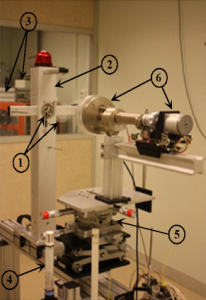Beta dosimetry irradiators

Beta dosimetry at the LNHB
As a primary laboratory in the field of ionizing radiation, the LNHB determines primary references for β standard sources in absorbed dose in tissues at a depth of 0.07 mm \(\overset{\circ}{D_{t}}(0.07)\) and in directional and individual dose equivalent rate at a depth of 0.07 mm \(\overset{\circ}{H’}(0.07;Ω)\), Ω being the considered direction.
The LNHB has a BSS2 (Beta Secondary Standard 2) irradiator developed by the PTB (Physikalisch-Technische Bundesanstalt) and adapted by the LNHB for primary measurements of β standard sources.
This irradiator consists of a source holder mounted on a bench. On this bench, the source support can be positioned at 4 fixed distances (11, 20, 30 and 50 cm).

To measure the absorbed dose rate in tissues, the reference instrument is the extrapolation ionization chamber according to ISO 6980. We use a PTW chamber type 23392.
This chamber has a variable collection volume by moving the collection electrode by means of a micrometric screw.

Adaptation of the BSS2 irradiation set to LNHB primary measurements
1 – source and filter
2 – source holder
3 – Pressure probe and control and monitoring unit
4 – temperature and humidity sensor
5 – rotating mounting
6 – extrapolation chamber with motorized motion of the collector electrode
The LNHB/LMD has 3 β sources:
– 90Sr-90Y: Eβmax = 2.28 MeV, T1/2 = 28.80 years
– 85Kr: Eβmax = 687 keV, T1/2 = 10.752 years
– 147Pm: Eβmax = 224.7 keV, T1/2 = 2.6234 years
Calibration and irradiation of dosimeters in radiation protection
Once these references have been established, another of the LNHB’s missions is to transfer the gray (Gy) and sievert (Sv) to users by offering them dosimeter irradiation, ionization chamber calibration and by providing them with a calibration certificate under COFRAC ISO 17025 accreditation or by making LNHB equipment and personnel available for testing.

Development of a transfer chain
In order to have a travelling standard for reference transfer between laboratories and thus ensure better traceability by organising national and international comparisons, the LNHB has developed an ionization chamber associated with a transfer chain.

Our job: metrology
dosimetry
Implemented methods for the establishment of national references must be adapted to the radiation type and its intensity. They are based on measurement technics such as calorimetry, ionometry and chemical dosimetry.
Radioactivity
The variety of the emitted radiation and physical forms of the sources oblige to adapt the measurement process in order to establish national references: methods with defined geometries, or 4 π countings geometries, coincidence countings, etc.
